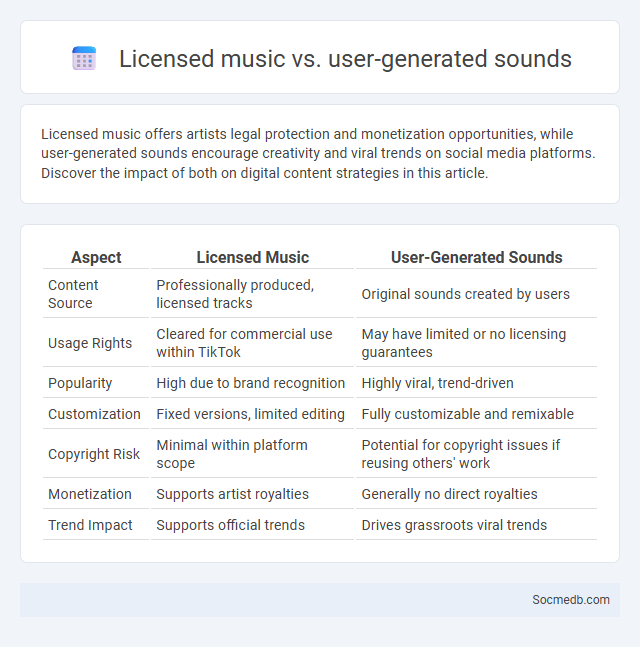
Photo illustration: licensed music vs user-generated sounds
Licensed music offers artists legal protection and monetization opportunities, while user-generated sounds encourage creativity and viral trends on social media platforms. Discover the impact of both on digital content strategies in this article.
Table of Comparison
| Aspect | Licensed Music | User-Generated Sounds |
|---|---|---|
| Content Source | Professionally produced, licensed tracks | Original sounds created by users |
| Usage Rights | Cleared for commercial use within TikTok | May have limited or no licensing guarantees |
| Popularity | High due to brand recognition | Highly viral, trend-driven |
| Customization | Fixed versions, limited editing | Fully customizable and remixable |
| Copyright Risk | Minimal within platform scope | Potential for copyright issues if reusing others' work |
| Monetization | Supports artist royalties | Generally no direct royalties |
| Trend Impact | Supports official trends | Drives grassroots viral trends |
Understanding Licensed Music: Definition and Features
Understanding licensed music involves recognizing the legal permission granted to use copyrighted songs within your social media content, ensuring compliance with copyright laws. Licensed music typically includes specific features such as usage rights, geographical restrictions, duration limits, and the type of platforms where the music can be shared. Properly using licensed music protects your social media channels from copyright strikes and enables your content to reach a wider audience securely.
What Are User-Generated Sounds?
User-generated sounds are audio clips created and uploaded by social media users, often used in videos, stories, or reels to enhance content engagement. These sounds include original music, voiceovers, sound effects, or dialogues that can be reused by others, fostering creativity and viral trends. Platforms like TikTok, Instagram, and Snapchat heavily rely on user-generated sounds to drive content discovery and community interaction.
Exploring Trending Sounds in Digital Media
Exploring trending sounds in digital media unlocks new ways to engage your audience and boost content visibility across platforms like TikTok and Instagram Reels. Leveraging popular audio clips enhances algorithmic reach and fosters viral potential by tapping into current cultural moments. Staying updated with viral sound trends ensures your content remains relevant, fresh, and highly shareable in a competitive social media landscape.
Copyright Considerations: Licensed Music vs. User-Generated Content
Using licensed music on social media requires strict adherence to copyright laws, often necessitating permissions or licensing fees to avoid infringement. User-generated content offers more flexibility but still demands careful attention to copyright rules, especially when incorporating third-party materials. Protecting Your content and respecting others' intellectual property ensures compliance and avoids potential legal issues on these platforms.
Impact on Audience Engagement: Which Sound Wins?
The impact of sound on audience engagement in social media is profound, with various audio types influencing user interaction differently. Popular sounds, such as trending music or catchy voiceovers, significantly boost watch time, shares, and comments, enhancing overall content reach. You should choose sounds that resonate emotionally with your target audience to maximize engagement and foster stronger connections.
Monetization Opportunities and Platform Policies
Social media platforms offer diverse monetization opportunities including sponsored content, affiliate marketing, subscription services, and in-app purchases, enabling creators and businesses to generate revenue directly from their audience. Platforms like Instagram, YouTube, and TikTok enforce specific policies governing content monetization, requiring compliance with guidelines on advertising standards, copyright regulations, and community rules to maintain eligibility for monetization programs. Understanding and adhering to these platform policies is crucial for maximizing monetization potential while ensuring sustainable growth and brand reputation.
Case Studies: Viral Success with Sounds
Case studies reveal that viral success on social media often hinges on the strategic use of trending sounds that resonate with target audiences. Platforms like TikTok and Instagram leverage audio clips to boost engagement, turning catchy tunes or relatable voiceovers into powerful tools for organic reach. By integrating these popular sounds into your content, you maximize visibility and connect emotionally with viewers, driving unprecedented growth.
Creative Flexibility Across Sound Types
Creative flexibility across sound types enhances your social media content by allowing you to blend music, voiceovers, and sound effects seamlessly. This dynamic approach boosts engagement by catering to diverse audience preferences and making your posts more memorable. Harnessing various audio styles increases the impact of your message and elevates overall user experience.
Choosing the Right Audio for Your Brand
Selecting the right audio for your brand on social media enhances user engagement and reinforces brand identity. Tailor sound elements to align with your target audience's preferences, industry trends, and platform-specific audio formats like Instagram Reels or TikTok sounds. Consistent use of branded audio, such as custom jingles or theme music, improves recall and strengthens emotional connections with followers.
Future Trends in Social Media Audio Content
Social media platforms are increasingly integrating audio content through features like live audio rooms, podcasts, and voice messages to capture rising user engagement. Innovations in voice recognition and AI-generated audio personalized experiences, enabling brands to create immersive and interactive audio marketing strategies. Emerging trends also highlight the growth of spatial audio technologies and audio NFTs, enhancing listener interaction and content monetization opportunities on social media.
 socmedb.com
socmedb.com